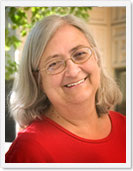 The story is about natural curiosity, love of knowledge and professional passion. Marilyn started her medical librarian career after acquiring a degree in anthropology. A combination of factors made her discover she had an inclination for librarianship. An aptitude test had shown her natural strength and abilities match those of librarians and teachers. Her job at Stanford in the pharmacology department gave her the opportunity to have frequent interactions with reference librarians at Lane. She felt the need for bigger challenges and higher satisfaction. She decided to acquire an MLS and started as an assistant in the inter-library loan department at Lane. Lane library director at the time thought it best she and another junior librarian acquire experience as librarians in other institutions before he could transfer them to higher positions.
The story is about natural curiosity, love of knowledge and professional passion. Marilyn started her medical librarian career after acquiring a degree in anthropology. A combination of factors made her discover she had an inclination for librarianship. An aptitude test had shown her natural strength and abilities match those of librarians and teachers. Her job at Stanford in the pharmacology department gave her the opportunity to have frequent interactions with reference librarians at Lane. She felt the need for bigger challenges and higher satisfaction. She decided to acquire an MLS and started as an assistant in the inter-library loan department at Lane. Lane library director at the time thought it best she and another junior librarian acquire experience as librarians in other institutions before he could transfer them to higher positions.
Marilyn draws her satisfaction from helping people find the information they need and feels teaching is very gratifying. She enjoys reading and acquiring knowledge. Her initial encounter with Medline was a three weeks course learning to search Elhill. Her first medical librarian job was at Mills Hospital. The librarian had to report to the medical staff affairs coordinator. She enjoyed running searches for physicians. Unlike her predecessor, she did not pile up search results’ cards, which at the time were received by mail. She felt opening books and periodicals to read and learn about medical subjects was rewarding. In general she could feel physicians were appreciative of her services. There was a library committee of physicians, however Marilyn at the time did not have the expertise to know how to manage such a committee. In retrospect she wishes she had the necessary skills to benefit from the power of a committee. The nurses’ library was a separate library with no librarian. She managed to consolidate both collections with the support of a male nurse. Later the library was transferred to the education department, a much better fit. At a later stage, around 1984, a merger of Mills Hospital and Peninsula Hospital created a hectic atmosphere. At that point she had one assistant and three or four volunteers. The assistant was let go, and Marilyn’s position was reduced to half time. The person in charge of the video collection was also laid off and the video collection was added to the library. There was no more time for reading, and consequently the job was less enjoyable. Marilyn later learned that administration had considered laying her off and leaving the library to be run by volunteers.
Early in her career at Mills Hospital, Marilyn encountered some objection to networking. However, this situation was soon reversed; NCNMLG (the Northern California Nevada Medical Library Group) started fostering personal networking for one-person libraries. Other networking opportunities presented themselves: Stanford Lane library offered privileges to several libraries in the area. Marilyn came once a week to check resources at Lane. In terms of access at the time, this was an excellent opportunity.
Marilyn by nature was not a politician, so in 1985, as soon as the opportunity to return to Lane was possible she grasped it. Moving to Lane meant there would no need to singlehandedly defend the library. There would be other librarians to share the responsibility for making hard decisions.
In 1985, searching Dialog was a class taught twice a week for two or three weeks. The physicians and researchers who attended had homework to do. Compaq computers were used to teach the class, unwinding feet of wire and finding phone jacks were part of the job, as there were no assigned classrooms. Each student had to have his or her Dialog password. To do the homework they had to use MeSH words.
In the early 1990s, there were big changes for reference librarians as an avalanche of systems and databases became available. Among these databases, Grateful Med, BRS and BRS Colleague, and new versions of Dialog were introduced. Knowledge Finder for Macs used “Fuzzy Logic.” Librarians were not very fond of it, but it provided ranking and related articles. Access to the University of California Melvyl system was part of an agreement with “Resource Libraries”, of which Lane was one.
In 1994 Marilyn developed and introduced Lane’s first website. The introduction of the World Wide Web to libraries in the mid 90s, Marilyn says, created an increased focus on teaching. There was a shift from students and physicians having to come to the library to do research, to coming to the library only to study. The nature, type and number of questions and search requests have changed. Now there is more need for technological and presentational marketing.
In this new environment Marilyn thinks there should be more emphasis on teaching efficient searching skills and critical thinking. There is a tendency of providing users with results without teaching the basics. She enjoys teaching efficient searching and helping library users find the information they need.
